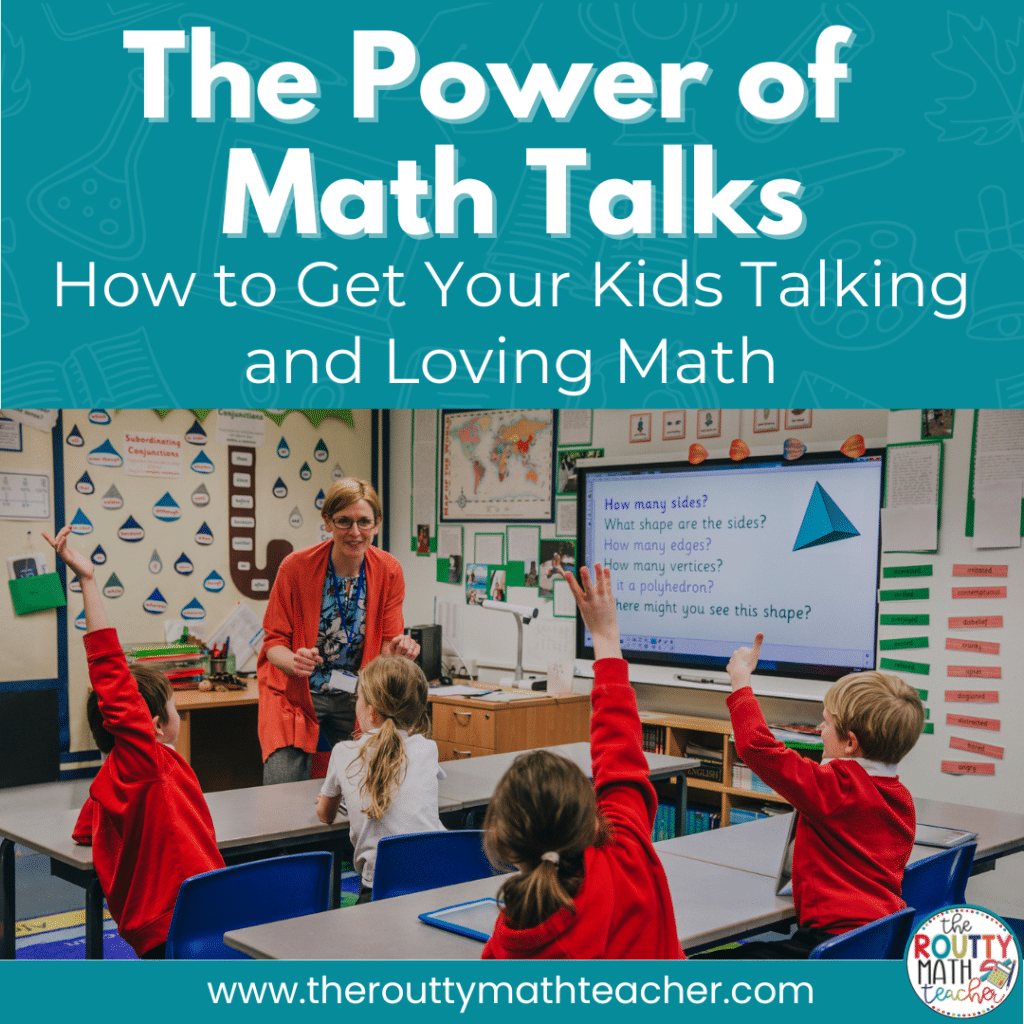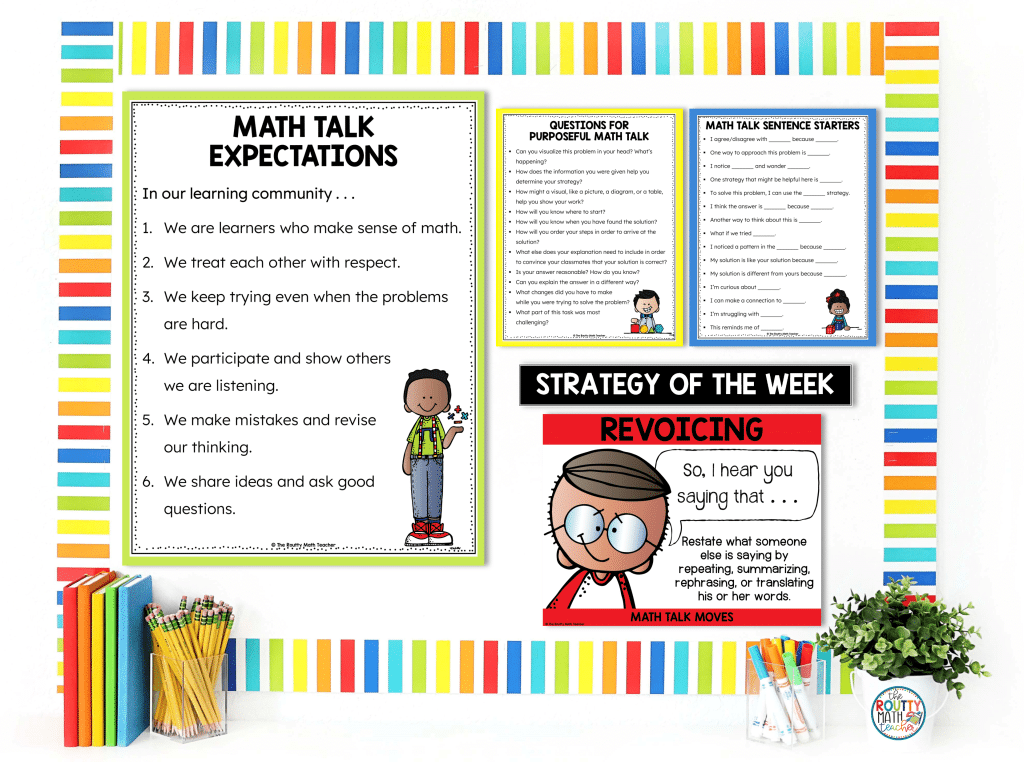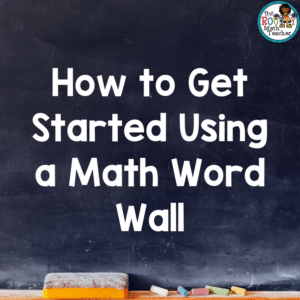Math Talks: Sparking Communication in Kids

In this comprehensive guide for mathematical discourse in the classroom, I explore the power of math talk and its significance in promoting student engagement and learning. I share strategies to encourage math talk, effective prompts, and ways to differentiate instruction via math talks. Additionally, I highlight the benefits of incorporating math talks in problem solving activities and suggest various ways to assess student learning through these discussions. Finally, I provide tips on how parents can support math talk at home to create a well-rounded learning experience.
Student A: I remember a way to find the answer for 16 times 7 using that one way Ms. Routt showed us. [Student A looks at his notes.] It’s called distributive property. We can break 16 into 12 and 4, and then multiply each part by 7. So, 12 times 7 is 84, and 4 times 7 is 28. Then we add them together.
Student B: Hmm, I’m not sure about that. I like using a different way– partial products. We multiply each number separately and then add them up. So, 1 times 7 is 7 and 6 times 7 is 42. Then we add them together– 7 + 42 = 49. [Student B’s eyebrows raise and furrow.] That doesn’t seem reasonable.
Student A: But doesn’t the distributive property give us the right answer? Let’s try it again. [Student A records his thinking on a whiteboard.] 12 times 7 is still 84, and 4 times 7 is still 28. The answer is 112.
Student B: Oh, now I get it! I made a mistake with my partial products. The 1 should be 10. 10 times 7 is 70 and 6 times 7 is 42. Then we add them together– 70 + 42 = 112. You’re right! Both ways gave us the same answer– 112.

The Power of Math Talks
The rich dialogue between these two students illustrates the power of math talk!
Whether exploring multiplication strategies or unraveling challenge problems, engaging in math talk provides an interactive platform for students to exchange ideas, challenge assumptions, and arrive at a consensus.
By actively discussing their approaches and considering different perspectives, students not only deepen their own comprehension but also develop crucial communication and critical thinking skills.
In this blog post, we will explore the following topics: the significance of math talk, strategies to encourage it, ways to use it to differentiate instruction, the benefits of using it during problem solving, how to assess it, effective prompts to get students talking, and how parents can support math talk at home.
We’ve got a lot to talk about, so let’s dive in!
What is Math Talk About and Why is it Important in the Classroom?
Math talk is an interactive dialogue centered around mathematical concepts, reasoning, and problem solving which requires students to articulate their thoughts, listen to their peers, and engage in meaningful discussions.
Math talk is crucial for several reasons:
- Enhances conceptual understanding:
Students develop a deeper understanding of mathematical concepts through math talk by explaining their ideas, asking questions, and making connections. - Promotes critical thinking:
Engaging in math talk encourages students to analyze problems, consider multiple perspectives, and justify their reasoning which helps to foster their critical thinking skills. - Encourages collaboration:
Math talk allows students to collaborate, listen to others’ ideas, and build upon each other’s knowledge. This collaborative learning environment promotes teamwork and a sense of community within the classroom.
How Do You Conduct a Math Talk?
The easiest way to conduct a math talk is through open strategy sharing.
During open strategy sharing, students discuss their strategies to solve a particular problem. Students then listen to each other and share their ideas.
The teacher probes students with questions related to how they determined the solution and students justify why they selected a particular solution path. During the discussion, the teacher highlights various strategies and emphasizes their similarities and differences.
How Can I Encourage Math Talk with My Students?
Creating an environment conducive to math talk is essential for encouraging students to participate actively.
Here are some strategies you can implement:
- Establish a safe and inclusive space: Foster a supportive classroom culture where all students feel comfortable sharing their ideas without fear of judgment or criticism.
- Use open-ended questions: Encourage students to think deeply by asking open-ended questions that require justification and multiple approaches. This prompts students to engage in meaningful math talk.
- Incorporate cooperative learning structures: Group activities and discussions enable students to learn from one another, collaborate, and engage in rich math talk.
- Active listening: Teach and model active listening skills, such as paraphrasing, summarizing, and asking clarifying questions. This promotes respectful and effective communication during math talks.
What Are Some Effective Math Talk Strategies for Elementary Students?
When working with upper elementary students, it’s essential to use strategies tailored to their developmental level and communication style.
Here are some effective math talk strategies:
- Partner talk: Allow students to discuss problems with a partner before sharing with the whole class. This provides a low-pressure opportunity to practice articulating and forming their ideas.
- Number talks: Engage students in discussions focusing on mental math strategies, encouraging them to share their thought processes and explain their reasoning. During number talks, students also learn how to connect to other students’ strategies and respectfully disagree with someone’s thinking.
How Can I Use Math Talks to Differentiate Instruction?
Math talk can be a powerful tool for differentiating instruction to meet the diverse needs of your students.
Here are some ways to differentiate instruction via math talks:
1. Before discussing a problem, allow students to talk with a partner to share their solution and get feedback before the class discussion. Students will be able to listen to their partner’s response and receive feedback from their partner that will help them refine their solution strategy.
2. Tailor the questions during math talk to scaffold students’ understanding. Begin with more straightforward questions and gradually increase the complexity to challenge and extend their thinking.
3. Use open middle questions to provide all students with an entry point and opportunity to make sense of the task at their level of comprehension. Then, allow students to compare strategies with a partner.
What Are the Benefits of Using Math Talk in Problem-Solving?
Math talks are essential when it comes to problem solving. It helps students make sense of the problems, explore different solution paths shared by their peers, and gain a deeper understanding of mathematical concepts.
Using math talk structures during problem solving also develops students’ metacognitive skills, allowing them to reflect on their thinking processes, analyze their problem solving strategies, and connect to other concepts.
What Are Some Ways to Assess Student Learning Through Math Talks?
Assessing student learning during math talks can provide valuable insights into students’ understanding. Using a checklist to assess students’ mathematical communication skills is a quick and easy way to better understand a student’s ability to think critically about math.
To get started with the checklist, consider the following attributes:
- Clarity of Explanation: Can the student articulate their ideas and explanations in a clear and organized manner?
- Use of Mathematical Vocabulary: Does the student demonstrate a good understanding and appropriate use of mathematical terms and vocabulary?
- Justification and Reasoning: Does the student provide logical reasoning and evidence to support their mathematical claims and solutions?
- Active Listening: Does the student actively listen to their peers, respond thoughtfully, and build upon others’ ideas during math talk?
- Collaboration and Engagement: Does the student actively participate in group discussions, contribute to problem-solving strategies, and engage in productive mathematical dialogue with peers?
After creating the checklist, actively observe students and take notes during math talk sessions, noting students’ contributions, reasoning, and use of mathematical vocabulary. Then, provide constructive feedback to students via one-on-one student conferences or summarized notes shared with the class.
What Are Some Examples of Effective Math Talk Prompts?
Engaging math talk prompts can stimulate student thinking and encourage deeper discussions.
Here are a few examples:
1. Explain how you arrived at your answer and why you think it is correct.
2. Can you think of another way to solve this problem?
3. What strategies did you consider using to tackle this problem, and how did you decide which one to move forward with?
4. Do you agree or disagree with your classmate’s solution? Explain your reasoning.
Using sentence stems during math talks can help students express their thoughts and engage in meaningful discussions. Sentence stems are prompts or partial sentences that provide a structure for students to start their responses. They serve as a scaffold, helping students organize their ideas and communicate their thinking more effectively.
For example, sentence stems like “I agree with _____ because . . .” or “One strategy I used was _____ because . . .” give students a starting point to share their perspectives and reasoning. Sentence stems encourage all students to actively contribute to math talk and promote a collaborative and inclusive classroom environment, regardless of their proficiency level.
How Can Parents Support Math Talk at Home?
Collaboration between teachers and parents is crucial for students’ overall development. Here’s how parents can support math talk at home:
1. Engage children in conversations about real-life math applications, pose math problems, and encourage them to explain their reasoning.
2. Engage in fun math games and puzzles that require verbalizing strategies and problem-solving steps, fostering math talk in a relaxed setting.
3. Offer access to math books, websites, or apps that encourage discussions and provide opportunities for exploring mathematical concepts together.
How to Get Started with Math Talks
Math talk is a powerful instructional tool that promotes active learning, critical thinking, and collaborative problem-solving.
By creating a supportive classroom environment, implementing effective strategies, and leveraging math talk prompts, we can enhance our students’ mathematical understanding and level of engagement.
Next Steps?
Once you understand what math talk is and how to use it in the classroom, it’s time to focus on getting the most from it.
Teachers often ask, “What is a math talk move?”. Understanding math talk moves help to guide both students and teachers during a discussion.
Modeling and using the moves during math talks will help students become better communicators and stronger math students. Read this blog post to learn the 7 essential math talk moves!
To learn more about how to get started using math talks in the classroom, download my Math Talk Toolkit using the form below.
Don’t forget– math journaling is a great way to start promoting mathematical thinking and communication skills in a low-pressure way.
Having students write about their thinking before sharing their thoughts with a partner is a good way to help students formulate their thoughts before they have to communicate them verbally via math talks.
However, whether you choose to incorporate math talks via math journals or classroom discussions, it’s essential to get our students communicating mathematically as often as we can.
Sound Off!
How do you encourage math talks in your classroom?





